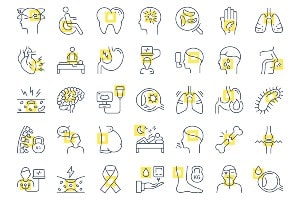About Giardia Lamblia

Learn about the disease, illness and/or condition Giardia Lamblia including: symptoms, causes, treatments, contraindications and conditions at ClusterMed.info.
Giardia Lamblia

| Giardia Lamblia |
|---|
Giardia Lamblia InformationHow can giardiasis be prevented?
How is giardiasis diagnosed?The best single test for diagnosing giardiasis is antigen testing of the stool. For antigen testing, a small sample of stool is tested for the presence of Giardial proteins. The antigen test will identify more than 90% of people infected with Giardia. Giardia also can be diagnosed by examination of stool under the microscope for cysts or trophozoites; however, it takes three samples of stool to diagnose 90% of cases. Despite requiring three samples of stool, microscopic examination of stool identifies other parasites in addition to Giardia that can cause diarrheal illness. Therefore, microscopical examination of stool has value beyond diagnosing giardiasis, as it can identify and diagnose other parasites as the cause of a patient's illness.Other tests that can be used for diagnosing giardiasis are collection and examination of fluid from the duodenum or biopsy of the small intestine, but these require tests that involve expense and discomfort. The string test is a more comfortable method for obtaining a sample of duodenal fluid. For the string test, a gelatin capsule that contains a loosely-woven string is swallowed. One end of the string protrudes from the capsule and is taped to the patient's outer cheek. Over several hours, the gelatin capsule dissolves in the stomach, and the string uncoils, with the last 12 inches or so passing into the duodenum. In the duodenum the string absorbs a small amount of duodenal fluid. The string then is untapped from the cheek and is removed. The collected duodenal fluid is expressed from the string and is examined under the microscope. Although more comfortable than some of the other tests, it is not clear how sensitive the string test is in diagnosing giardiasis. How is giardiasis treated?The most common treatment for giardiasis is metronidazole (Flagyl) for 5-10 days. It has an efficacy rate of 75% to 100%, but it often causes gastrointestinal side effects such as nausea and a metallic taste as well as dizziness and headache. Despite its effectiveness, metronidazole is not approved by the FDA in the U.S. for treatment of giardiasis.Tinidazole has replaced furazolidone as the FDA-approved drug for treatment of the condition, and is highly effective at treating giardiasis (>90%). It also can be given as a single dose and is well tolerated. Furazolidone and Quinacrine are effective for treating giardiasis but are no longer available in the U.S. Albendazole and mebendazole are effective alternative agents, but these are not approved for used in the U.S. Paromomyin is less effective than other treatments.Occasionally, treatment fails to eradicate Giardia. In such cases, the drug may be changed or a longer duration or higher dose may be used. Combination therapy also may be effective (e.g., quinacrine and metronidazole). What is giardiasis?
What signs and symptoms does giardiasis cause?The most common manifestations of giardiasis are diarrhea and abdominal pain, particularly cramping; however, diarrhea is not invariable and occurs in 60% to 90% of patients. Other common manifestations include:
Who is at risk for giardiasis?Giardiasis occurs where there is inadequate sanitation or inadequate treatment of drinking water. Giardiasis is one of the causes of "travelers diarrhea" that occurs during travel to less-developed countries, for example the Soviet Union, Mexico, Southeast Asia, and western South America. Giardiasis is a common cause of outbreaks of diarrhea in day-care centers because of the high probability of fecal-oral contamination from children; the children, their families, and day care center workers, all are at risk for infection. In fact, children are three times more likely to develop giardiasis than adults. Hikers exploring back-country areas who drink from contaminated fresh water lakes also are at risk for developing giardiasis. Individuals who practice anal/oral sex also may become infected. |
More Diseases
A | B | C | D | E | F | G | H | I | J | K | L | M | N | O | P | Q | R | S | T | U | V | W | X | Y | Z
Diseases & Illnesses Definitions Of The Day
- Noncancerous Colloid Thyroid Nodule (Thyroid Nodules) ‐ How are thyroid nodules diagnosed?, Introduction to thyroid nodules …
- Skin, Laser Resurfacing (Laser Resurfacing) ‐ CO2 Laser Resurfacing, Complications of Laser Skin Resurfacing …
- Malignant Fibrous Histiocytoma (Bone Cancer Overview) ‐ Are there any treatments or medications that relieve bone cancer pain? …
- Double Vision ‐ Is it possible to prevent double vision?, What are the symptoms and signs of double vision? …
- Ageusia (Taste Disorders) ‐ Are taste disorders serious?, Can taste disorders be treated? …
- Autism Screening and Diagnosis ‐
- Alpha-fetoprotein Blood Test ‐ In which situations are high blood (serum) levels of AFP used as a tumor marker? …
- Polymyalgia Rheumatica ‐ How do health care professionals make a diagnosis of polymyalgia rheumatica? …
- Stump Appendicitis (Appendicitis) ‐ Appendicitis definition and facts, Are there long-term consequences of appendectomy? …
- Gonorrhea (Gonorrhea In Women) ‐ Gonorrhea facts, How is gonorrhea diagnosed?, What are sexually transmitted diseases (STDs)? …